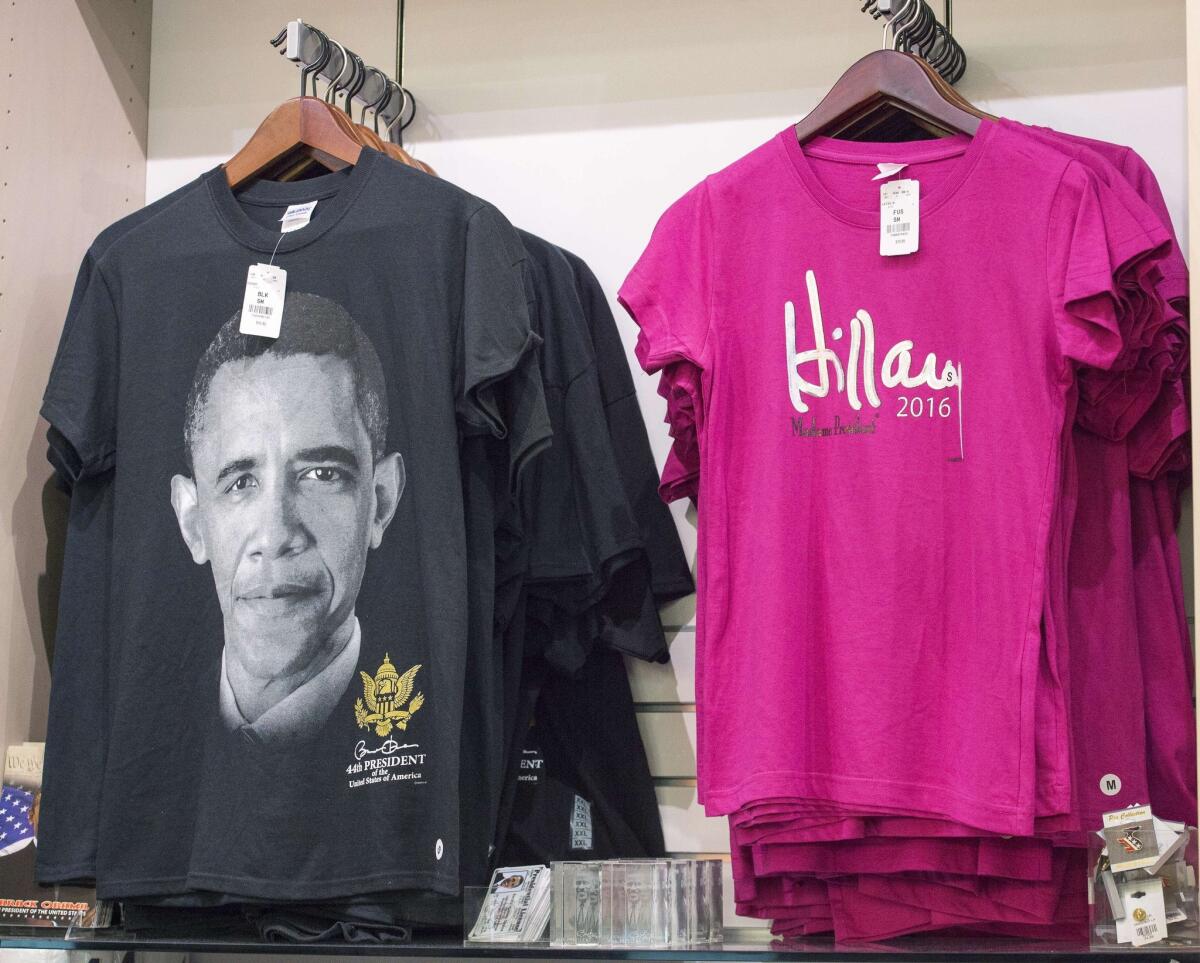Op-Ed: The changing face of centrist campaigning

T-shirts with an image of President Barack Obama and the name of Democratic Presidential hopeful Hillary Clinton are for sale in a gift shop at Ronald Reagan National Airport in Washington on June 8.
- Share via
Imagine three presidents. The first sold a moderate message to win a three-way race with 49% of the vote. The second sold a conservative one and won with just under 51% of the vote. And the third ran a liberal campaign and won with just over 51% of the vote.
Of the three presidents, who had the “broad” campaign of wide appeal? And who had the narrow one of partisan mobilization?
If you know your politics, you know these campaigns. The first is Bill Clinton’s 1996 run, the second is George W. Bush’s in 2004, and the third is Barack Obama’s 2012 reelection bid. And of them, Obama’s was the most successful: Not only did he win an outright majority, but he won the most votes — as a share of the total — in a presidential election since George H.W. Bush, and became the first Democratic president since Franklin Roosevelt to win two national majorities.
Looking to 2016, Hillary Rodham Clinton wants to achieve what Obama did, and so she’s running a version of his campaign, openly appealing to the groups that supported him. In the last two months, she’s endorsed criminal justice reform, pushed expansive immigration reform and called for an overhaul of voting laws to improve access.
But Washington pundits, and mainstream reporters, are disturbed. “Hillary Rodham Clinton appears to be dispensing with the nationwide electoral strategy that won her husband two terms in the White House and brought white working-class voters and great stretches of what is now red-state America back to Democrats,” wrote Jonathan Martin and Maggie Haberman of the New York Times.
“My problem with this approach,” wrote Ron Fournier of National Journal, of Clinton’s strategy, “is that it works only until election day, when a polarizing, opportunistic candidate assumes the presidency with no standing to convert campaign promises into results.”
Likewise, again in the New York Times, David Brooks bemoaned the Clinton approach as “bad” for the country. “If Clinton decides to be just another unimaginative base-mobilizing politician, she will make our broken politics even worse,” he argued.
Each critique comes to the same place: Mobilizing individual groups, instead of using a broad message, will polarize the country, make it harder to win, and make it harder to govern. But this argument has a problem: reality.
Despite his inclusive, centrist message, Bill Clinton never won a majority of the vote. And when he entered office in 1993, he faced a polarized Republican minority that blocked his core programs, from a small stimulus package to healthcare reform.
At no point did this change; instead, Clinton abandoned liberal legislation and co-opted Republican ideas, softening them for Democrats. Arguably, Republicans never accepted Clinton’s presidency; it’s why a sex
scandal culminated in the first impeachment proceedings since the 1860s.
This same dynamic was at work in 2009, after Barack Obama won 53% of the vote with an inspirational campaign of post-partisan change. Despite his huge vote totals, Republicans refused to work with him, rejecting the stimulus package (and any negotiations over its substance), abstaining from the healthcare debate (and any negotiations over its substance), and openly pledging constant opposition.
“The single most important thing we want to achieve is for President Obama to be a one-term president,” said Sen. Mitch McConnell, ahead of the midterm election in 2010. In 2011, after the GOP landslide, McConnell — and John A. Boehner in the House of Representatives — would try to make good on the promise, slowing Congress to a halt and forcing confrontations over routine measures, such as lifting the debt ceiling.
Obama was only able to accomplish what he did in his first two years because of the large Democratic majorities in the House and Senate.
Liberal mobilization, part of Obama’s strategy, had worked. Indeed, it worked again in 2012 and 2013, when Democrats energized their voters, reelected Obama, elected a larger Senate majority, and made headway on appointments and executive branch actions the following year.
Beyond the facts of this Democratic administration and the last one, the biggest blow to the argument over Hillary Clinton’s “narrow” campaign comes from public opinion.
Since 2000, Americans have moved to the left on gay rights, immigration, climate change, and criminal justice — issues on which Clinton is allegedly “polarizing” the public.
If Washington pundits can’t see that, it’s because they’re looking in the wrong place. The rural and suburban whites who brought Bill Clinton to victory in 1992 and 1996 aren’t the center of American politics anymore. That belongs to the Latinos, African Americans, Asian Americans, single women, union members, young people and college students who gave Obama his victories.
The electorate is younger and browner, and more liberal as a result. Put differently, Clinton is mobilizing the base, but she’s also speaking to the center. It just looks different than it did.
To insist otherwise, to describe this as “narrow,” is to delegitimize the Democratic majorities of 2008 and 2012 and suggest, openly, that a presidential candidate isn’t “broad” unless he (or she) is focused on white Americans.
Jamelle Bouie is a staff writer for Slate.
Follow the Opinion section on Twitter @latimesopinion and Facebook
More to Read
A cure for the common opinion
Get thought-provoking perspectives with our weekly newsletter.
You may occasionally receive promotional content from the Los Angeles Times.






